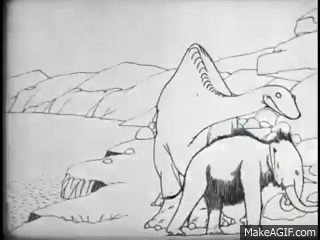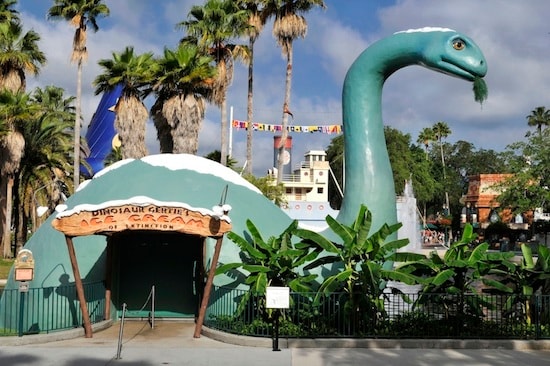If I were to ask anyone on the street what animation is, I think most would reply with a reference to a Disney film. This tremendous emotional affinity that people have with Disney is rooted in its commitment to principles that past historical figures have either founded or contributed to. Gertie the Dinosaur (1914) marks the start of the discovery of animation’s potential to create something mystical that society knows nothing of, which in this case, is a dinosaur.
 Gif obtained here.
Gif obtained here.
Painstakingly created by Winsor McCay (1869-1934), Gertie charmed many hearts; it was the first character to embody the sort of cheekiness one might find in a child. Many might brush this accomplishment aside but at that time, along with his split system and use of cycling and registration marks, McCay’s work was greatly admired. However, what I find even more impressive is McCay’s source of inspiration for this vaudeville act/ film. He deliberately featured a dinosaur to silence skeptics who cast doubts on his detailed drawings in his earlier film How a Mosquito Operates (1912), which they claim was a visual trick!
 Gif obtained here.
Gif obtained here.
McCay was also shunned by his boss, William Hearst. Hearst was displeased with McCay’s success, so he prohibited McCay’s vaudeville performances and limited McCay’s job scope to newspaper editorials. In response, McCay signed a contract with Fox and re-engineered the performance into a film. In his later years, he became well known for his political cartoons, which drove him to create The Sinking of the Lusitania (1918).
 Image obtained here.
Image obtained here.
Eighteen thousand miles from the moon is some slide, but I’ll get up there again some way! – The Best of Little Nemo in Slumberland
Though his animator life after Gertie was rocky and financially unsuccessful, I respect McCay for his tenacious spirit in an era characterized by the pursuit of industrial efficiency (Curtis, 2019). It was no easy feat to survive and dabble in animation simultaneously in this era; the path that McCay took was not typical of others in the past. He worked for himself and not for emerging and popular studios like Bray and Fleischer Studios. This meant that he was vulnerable to market fluctuations for the demand of animation and media content. He also could not focus entirely on animation as he does it as a “side hobby”. Nonetheless, he could pursue his own ideas and not be bound to someone else’s vision (keep in mind that animation was a very technical and mechanical process that often revolved around one person’s idea). This made me ponder whether I would have taken his path or enrolled myself in a studio then (of course under the assumption that I have his skills!)…
Ultimately, I think McCay’s story as an animator is dull yet intriguing, something reflective of most of ours, which seems to make his achievements more relatable (if you get what I mean…). I’m thankful I got to know his story oh and present about it too haha!
 Check out Disney’s tribute to McCay here (image source).
Check out Disney’s tribute to McCay here (image source).
Sources:
- Curtis, S., Ohmer, S., Sandler, K., Gadassik, A., Johnston, A., & Rehak, B. (2019). The Silent Screen, 1895-1928 In Curtis, S. (Ed.), Animation (Behind the Silver Screen Series).
- Nathan, D. L., & Crafton, D. (2013). The Making and Re-making of Winsor McCay’s Gertie (1914). Animation, 8(1), 23–46.
- Winsor McCay Facts
- In-depth analysis of Gertie
- Animated films before and beyond Gertie
- Winsor McCay: His life and art